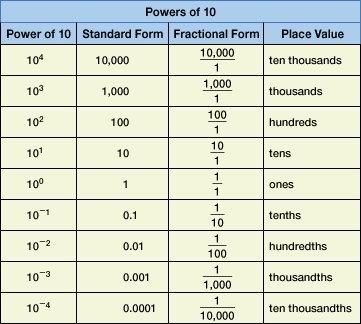Arithmetic » Powers and logarithms
Powers and Logarithms
Powers and Roots
Powers
The power of a number is a method of indicating how many times a number is multiplied by itself. For example, 54 means “5 to the power of 4.” That is, 5 multiplied by itself 4 times. The 5 is the base number and 4 is the power.
Example
24 = 2 × 2 × 2 × 2 = 16
Read “two to the fourth power equals sixteen.”
Squared powers: When a number has a power of 2, it is commonly referred to as “squared.” For example, 52 is read as “five squared” or “five to the second power.”
Cubed powers: When a number has a power of 3, it is commonly referred to as “cubed.” For example, 63 is read as “six cubed” or “six to the third power.”
Negative powers: It means how many times to divide by the number.
Example
Powers of zero: Any number raised to the zero power always equals 1.
Examples
40 = 1
(-69)0 = 1
Powers of ten: The scientific notation and various day-to-day applications use power of ten.

Copyright © Houghton Mifflin Company
Roots
A root is a number that when multiplied by itself a specified number of times will produce a given number.
Square roots: The common application in mathematics is finding the square roots. The symbol √ is called a radical sign. The square root of 81 (written as √81) equals 9. In other ways, when the number 9 is multiplied by itself, it produces the number 81.
The collection of numbers whose square roots are whole numbers are called perfect squares. The first ten perfect squares are 1, 4, 9, 16, 25, 36, 49, 64, 81 and 100. And the square root of each of these numbers is 1, 2, 3, 4, 5, 6, 7, 8, 9 and 10 respectively. The estimation method is commonly used to find the square root of a number that is not a perfect square.
Example
Find the square root of 41.
- The number 41 cannot be reduced and it falls between the two perfect roots 36 and 49. We know that √41 must be between √36 and √49.
- Therefore, √41 must be greater than 6 and less than 7 because √36 = 6 and √49 = 7.
- Estimate the square root of 41 at 6.5, which is closest to the correct answer. The square root of 41 is actually 6.403.
In the fractional method, the square root of a number is written with a 1⁄2 as the exponent instead of a radical sign. For example, √31 = 311⁄2
Cube roots: The cube root of 64 (written as 3 √64) equals 4. That is, when the number 4 is cubed (4 multiplied by itself then multiplying the product (16) by 4 again), it produces the number 64. The clarification for ‘cube’ and ‘cube root’ confusion is given below.
- The cube of 27 = 273 = 27 × 27 × 27 = 19,683
- The cube root of 27 = 3√27 = 3
In the fractional method, the cube root of a number is written with an exponent of 1⁄3. For example, 3√125 = 1251⁄3
Law of Exponents
- Rule 1: When multiplying numbers with powers, the powers can be added if the bases are the same.
Example
42 × 44 = (4 × 4) × (4 × 4 × 4 × 4)
= 4 × 4 × 4 × 4 × 4 × 4
= 46 or 42 × 44
= 4(2+4)
= 46
- Rule 2: When dividing numbers with powers, the powers can be subtracted if the bases are the same.
Example:
or
106 ÷ 103 = 10(6 − 3) = 103
